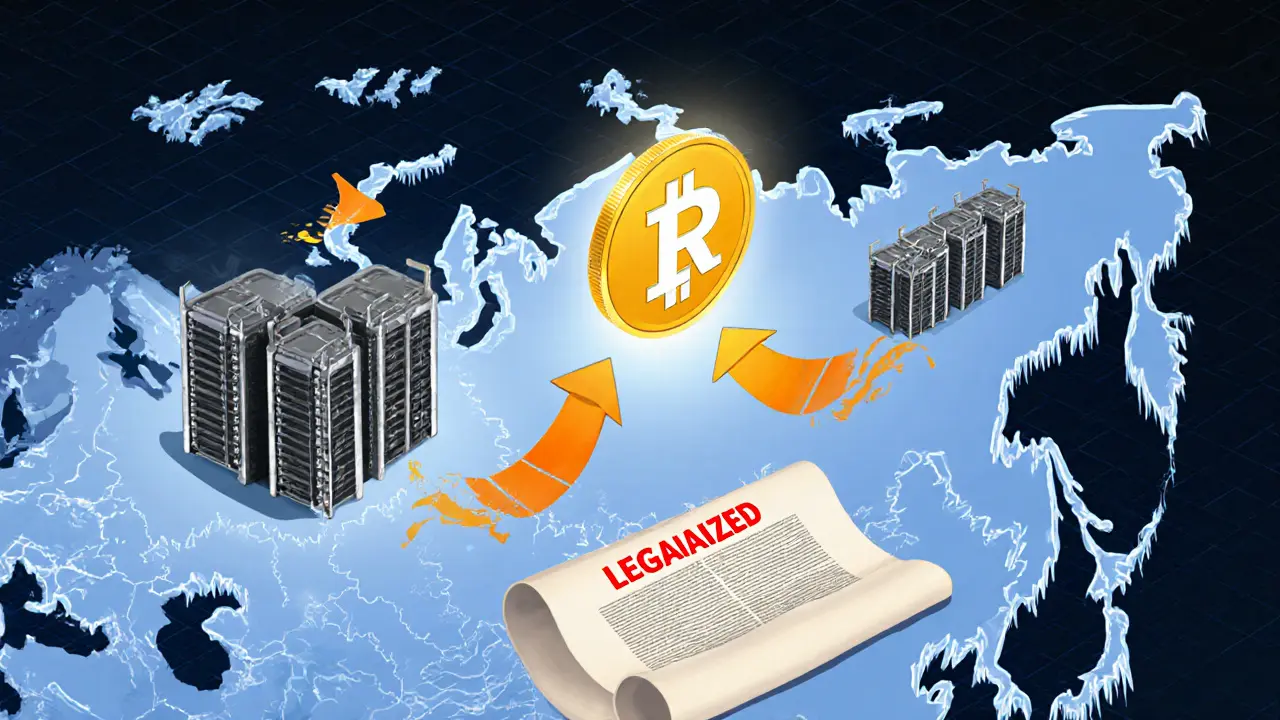Russia Legalizes Crypto Mining to Dodge Sanctions

Russia Crypto Sanctions Evasion Calculator
When Russia the world’s largest country, currently under extensive Western sanctions announced the legalization of crypto mining, analysts say it’s a calculated move to keep its economy afloat.
Quick Takeaways
- Russia legalized crypto mining and cross‑border crypto payments in early 2025 as part of a broader sanctions‑evasion strategy.
- The ruble‑backed stablecoin A7A5 has moved over $51billion since its launch.
- Western authorities, led by the US Treasury’s OFAC and the UK’s OFSI, have slapped sanctions on the exchanges and firms enabling the network.
- Blockchain analysts note that while the system is hard to monitor, the traceability of crypto transactions offers tools for disruption.
- Experts warn that crypto’s market size limits its ability to replace traditional dollar‑euro trade flows.
What the New Law Actually Says
The decree, signed in February 2025, removes the previous ban on large‑scale mining operations and formally permits crypto‑related cross‑border payments. It defines "crypto mining" as the generation of digital assets using electricity‑intensive hardware, and it clarifies that revenues from such activity are exempt from the “foreign currency” restrictions that have crippled other sectors of the Russian economy.
Crucially, the law grants mining companies a legal pathway to sell their output to foreign buyers via stablecoins, removing the need to convert to dollars or euros. The legislation also establishes a state‑backed licensing board that will approve mining farms and audit their electricity consumption.
Why Mining Matters for Sanctions Evasion
Russia already runs the world’s third‑largest mining industry, with estimates of more than 30GW of hash power. By legalizing the sector, the government can formalize revenue streams that flow through the cryptocurrency ecosystem, sidestepping the SWIFT‑based banking system that sanctions target.
More than just creating coins, mining farms can act as liquidity generators. When a farm mines a new token, it can immediately sell it on a sanctioned exchange for a stablecoin like A7A5. That stablecoin, pegged to the ruble, can then be transferred abroad without triggering the same red‑flags that a direct ruble‑to‑dollar wire would.
The A7A5 Stablecoin - Russia’s Digital Ruble
A7A5 a ruble‑backed stablecoin launched in February 2025 by the Kyrgyzstan‑based firm Old Vector quickly became the linchpin of the crypto‑evasion network. Backed by Promsvyazbank a state‑owned Russian bank and financed by Moldovan oligarch Ilan Shor, A7A5 handled $9.3billion in the first four months alone.
The token’s design mirrors a traditional ruble account but lives on a blockchain, making it hard for sanctions agencies to freeze the assets without first identifying the wallet owners. By July 2025, the network had processed $51.17billion, according to blockchain analytics firm Chainalysis.

Sanctioned Exchanges and the Shadow Crypto Economy
The ecosystem relies on a handful of exchanges that have either been sanctioned or operate in the grey zone. Garantex a crypto exchange with deep Russian ties, sanctioned by the US in 2022 was the primary market for A7A5 during its launch phase. When Garantex became a liability, former employees founded Grinex an exchange expressly built to bypass sanctions, sanctioned by the US in August 2025.
These platforms operate on a “small subset” of global crypto services, creating an insular network that limits exposure to Western compliance regimes. The UK has also sanctioned associated entities in Luxembourg and Kyrgyzstan, targeting the financial bridges that move crypto into weapons procurement channels.
Western Countermeasures
On 20August2025, the US Treasury’s Office of Foreign Assets Control (OFAC) made a historic move: it designated a virtual‑currency mining company as a sanctions evasion facilitator. The designation, announced by Under Secretary Brian E. Nelson, marked the first time a crypto mining firm was directly targeted under US sanctions law.
The UK’s Office of Financial Sanctions Implementation (OFSI) issued parallel sanctions against Old Vector, Grinex, and several Kyrgyz‑based financial intermediaries. Together, these actions aim to choke the liquidity pipelines that feed A7A5 and similar tokens.
Chainalysis notes that because blockchain transactions are publicly visible, authorities can trace flows from mining farms to stablecoin wallets, then to offshore banks. This visibility has led to the freezing of several high‑value wallets and the arrest of more than 40 individuals linked to the network.
How Effective Is Crypto for Sanctions Evasion?
Expert bodies such as the Bitcoin Policy Institute argue that crypto’s role is limited. Bitcoin’s market cap hovers around $400billion-roughly the same as Russia’s pre‑war export volume-but the volatility and liquidity constraints make it unsuitable for large‑scale commodity trade.
Nevertheless, crypto offers a useful “last‑mile” solution: it can move smaller, high‑value payments that are difficult to block, such as procurement of military components or procurement services for sanctioned entities.
Academic research shows Russia is not alone; nations like North Korea and Venezuela use similar tactics. The key difference is scale: Russia’s mining capacity and the introduction of a state‑backed stablecoin give it a more robust, albeit still constrained, financial lifeline.
Future Outlook - What’s Next for Russia’s Crypto Strategy?
Analysts expect the Russian government to double‑down on mining incentives, offering tax breaks and preferential electricity rates to keep the hash power domestic. At the same time, they anticipate tighter coordination among US, EU, and UK regulators to target the ancillary services-Kyrgyz banks, payment processors, and even hardware suppliers.
In the short term, the A7A5 ecosystem will likely expand its retail offerings, allowing ordinary Russian citizens to buy stablecoins using bank cards. That could create a “crypto‑krona” effect, where everyday transactions shift partially onto blockchain platforms, further eroding the reach of traditional sanctions.
However, the inherent traceability of blockchain may eventually become Russia’s undoing. As enforcement agencies refine their analytics, more wallets will be flagged, and the cost of operating in the shadow crypto economy could rise sharply.
Key Takeaways for Readers
- Legalizing mining gives Russia a state‑sanctioned avenue to generate crypto‑based revenue.
- The A7A5 stablecoin is the cornerstone of the new financial architecture.
- Western sanctions are now targeting mining firms, exchanges, and the financial bridges that move crypto abroad.
- While useful for small‑scale evasion, crypto cannot replace traditional dollar‑euro trade flows.
- Future success depends on Russia’s ability to stay ahead of blockchain analytics and regulatory crackdowns.
| Entity | Primary Role | Sanction Date | Current Status |
|---|---|---|---|
| Garantex | Crypto exchange handling A7A5 trades | 2022 (US) | Restricted, limited activity |
| Grinex | Sanctions‑bypass exchange (2024 launch) | August2025 (US) | Designated, assets frozen |
| Old Vector | Issuer of A7A5 stablecoin | August2025 (UK) | Designated, limited banking access |
| Promsvyazbank | State‑owned bank backing A7A5 | Not directly sanctioned (but under watch) | Operating under heightened compliance |

Frequently Asked Questions
Why did Russia choose to legalize crypto mining now?
Legalization gives the state a way to formalize revenue from its massive hash‑power, creates a legal shield for mining firms, and opens a channel to move funds abroad without using the SWIFT system, which is heavily targeted by sanctions.
What is the A7A5 stablecoin and why is it important?
A7A5 is a ruble‑pegged token issued by Old Vector. It lets Russian entities convert mined crypto into a digital ruble that can cross borders on blockchain networks, sidestepping traditional banking restrictions.
How are Western governments responding?
The US Treasury’s OFAC and the UK’s OFSI have sanctioned key exchanges, the stablecoin issuer, and even a mining company, aiming to cut off the liquidity pipelines that feed the crypto‑evasion network.
Can crypto fully replace the dollar/euro for Russian trade?
No. The total market cap of major cryptocurrencies is far smaller than Russia’s annual export volume, and price volatility makes large‑scale trade risky. Crypto is useful for niche, high‑value transfers, not for wholesale commodity sales.
What does the future hold for Russia’s crypto strategy?
Expect more incentives for mining, broader retail access to stablecoins, and a continuing cat‑and‑mouse game with regulators. As analytics improve, more wallets will be flagged, raising the cost of operating in the shadow crypto economy.
